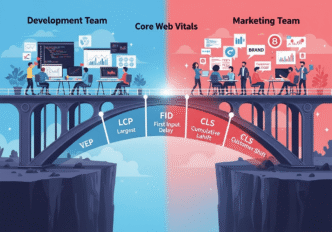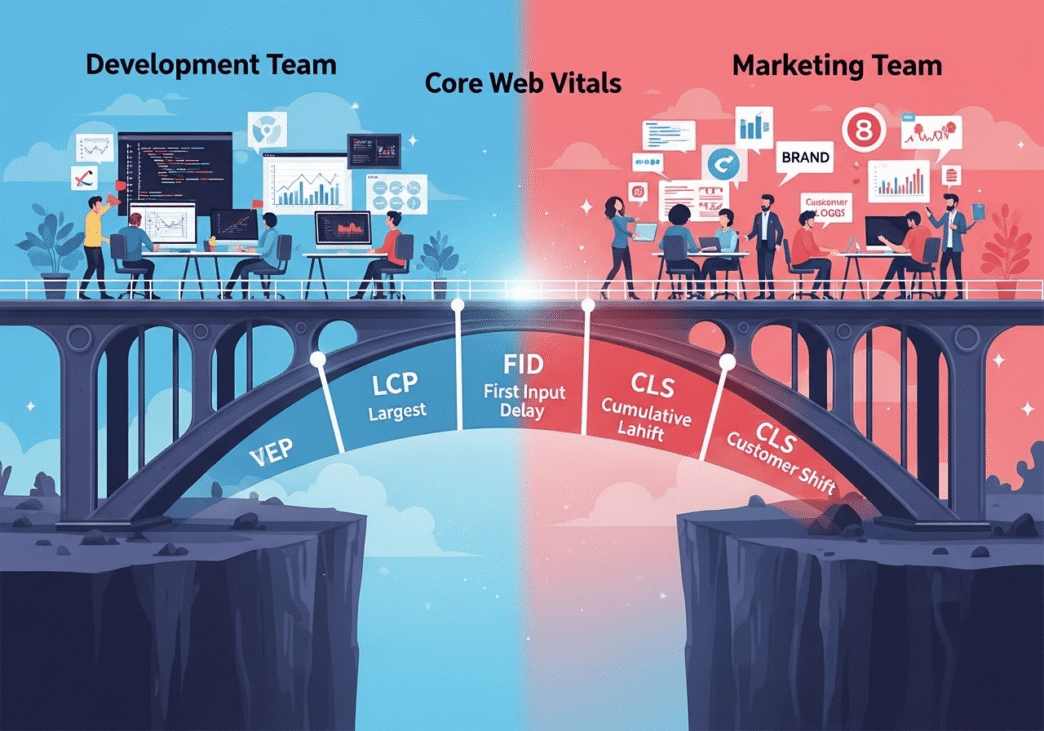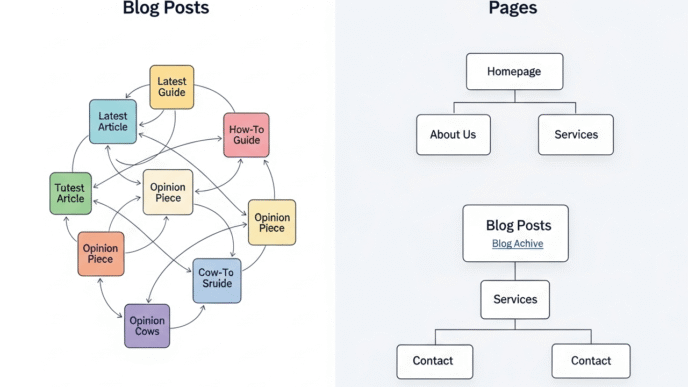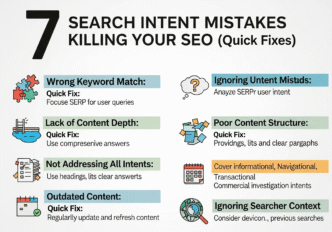Picture this: Your marketing team is celebrating a 40% increase in organic traffic, while your development team is pulling their hair out because the website keeps failing Google’s Core Web Vitals assessment. Meanwhile, both teams are speaking completely different languages about the same problem – like watching a sitcom where nobody realizes they’re talking about the same thing.
Sound familiar? Core Web Vitals communication often feels like trying to translate between Klingon and ancient Latin. Developers speak in milliseconds and JavaScript bundles, while marketers think in conversion rates and customer journeys. The result? Missed deadlines, frustrated teams, and websites that underperform.
But here’s the thing: team collaboration around Core Web Vitals doesn’t have to be a corporate nightmare. When developers and marketers finally speak the same language about performance, magic happens. Projects move faster, results improve dramatically, and suddenly everyone’s working toward the same goals instead of accidentally sabotaging each other.
Table of Contents
ToggleWhy Is Core Web Vitals Communication So Challenging Between Teams?
Core Web Vitals communication breaks down because developers and marketers have fundamentally different perspectives on the same metrics. It’s like having two people describe the same elephant – one focuses on the trunk mechanics while the other cares about the overall parade experience.
Developer Perspective:
- Technical metrics (LCP, FID, CLS scores)
- Code optimization challenges and solutions
- Infrastructure limitations and requirements
- Implementation timelines and complexity
Marketing Perspective:
- Business impact (conversions, revenue, rankings)
- User experience and customer satisfaction
- Campaign performance and ROI metrics
- Competitive advantage and market positioning
The disconnect happens when developers say “We improved LCP by 800ms” and marketers think “So what?” – while marketers say “Conversion rates are down 15%” and developers think “Not my problem.”
Pro Tip: The key to successful Core Web Vitals communication is creating a shared vocabulary that translates technical improvements into business outcomes. Both teams need to understand how their work impacts the other’s success metrics.
How to Align Developers and Marketers on Core Web Vitals Goals?
Developer marketing alignment requires establishing common ground and shared objectives. Think of it as creating a bilingual dictionary where everyone can understand both the technical and business sides of performance.
Creating Shared Goals Framework
Business-Driven Technical Objectives:
- LCP under 2.5s = 15% conversion rate improvement
- FID under 100ms = 25% bounce rate reduction
- CLS under 0.1 = 20% mobile user satisfaction increase
- All metrics “Good” = 30% SEO ranking boost potential
Technical-Driven Business Metrics:
- Image optimization = faster product page loading = higher sales
- JavaScript optimization = smoother interactions = better user experience
- Layout stability = fewer accidental clicks = improved conversion funnels
- Mobile performance = better mobile rankings = increased organic traffic
Communication Bridge Strategies
For Developers (translating to business impact):
- “This code optimization will reduce bounce rates by X%”
- “Implementing lazy loading will improve conversion rates on mobile”
- “Fixing layout shifts will prevent users from clicking wrong buttons”
- Server optimization will help us rank better in search results
For Marketers (understanding technical constraints):
- “This performance improvement requires 2 weeks of development time”
- “Adding that tracking script will slow down the site by 300ms”
- “This design change will cause layout shifts and hurt Core Web Vitals”
- The new feature needs to be built with performance in mind
Pro Tip: Create a “translation guide” that maps technical improvements to business metrics. When developers say they’ve optimized the critical rendering path, marketers should immediately understand this means faster page loads and better conversion rates.
What Are the Best Core Web Vitals Team Communication Strategies?
Core Web Vitals team communication strategies that actually work focus on creating shared understanding rather than trying to make everyone an expert in everything.
The Performance Dashboard Approach
Create a shared dashboard that shows both technical and business metrics:
| Metric Category | Developer View | Marketing View | Shared KPI |
|---|---|---|---|
| Loading Speed | LCP: 1.8s | Bounce rate: 35% | Page abandonment |
| Interactivity | FID: 85ms | Click-through rate: 4.2% | User engagement |
| Visual Stability | CLS: 0.06 | Conversion rate: 3.1% | User experience |
| Overall Performance | Core Web Vitals: Pass | Revenue: +25% | Business impact |
Weekly Performance Standups
Cross-functional teams benefit from regular performance-focused meetings:
Meeting Structure (15 minutes max):
- Performance scorecard review (5 minutes)
- Impact on business metrics (5 minutes)
- Upcoming optimizations and their expected business impact (3 minutes)
- Blockers and collaboration needs (2 minutes)
Meeting Attendees:
- Lead developer (technical perspective)
- Marketing manager (business perspective)
- Product owner (user experience perspective)
- Analytics specialist (data perspective)
Shared Documentation Standards
Technical Communication best practices:
- Always include business impact in technical specifications
- Use before/after comparisons with both technical and business metrics
- Provide timeline estimates for marketing planning
- Explain user experience impact of technical changes
Performance Communication templates:
Performance Improvement Proposal:
- Technical change: [What we're optimizing]
- Expected performance impact: [LCP/FID/CLS improvements]
- Business impact: [Conversion/traffic/revenue effects]
- Timeline: [Development and testing timeline]
- Resources needed: [Development hours, tools, etc.]
- Success metrics: [How we'll measure success]
How to Explain Core Web Vitals to Marketers Without Losing Them?
Explain Core Web Vitals to marketers by focusing on business outcomes rather than technical details. It’s like explaining how a car works – marketers need to know it gets them from A to B, not the intricate details of the combustion engine.
Core Web Vitals in Marketing Terms
Largest Contentful Paint (LCP) = “Time to First Impression”
- Marketing impact: How quickly customers see your main content
- Business correlation: Every 100ms improvement = 1% conversion increase
- Campaign relevance: Faster loading = better ad campaign performance
- Competitive advantage: Users compare your speed to competitors instantly
First Input Delay/Interaction to Next Paint (FID/INP) = “User Frustration Index”
- Marketing impact: How responsive your site feels to customer actions
- Business correlation: Poor interactivity = 40% higher bounce rates
- Campaign relevance: Slow interactions kill conversion momentum
- Customer experience: Unresponsive sites feel broken to users
Cumulative Layout Shift (CLS) = “Accidental Click Prevention”
- Marketing impact: How stable your layout is during loading
- Business correlation: Layout shifts = wrong button clicks = lost conversions
- Campaign relevance: Shifting layouts break conversion funnels
- Trust factor: Unstable sites feel unprofessional and unreliable
Marketing-Friendly Explanations
Instead of: “We need to optimize our JavaScript bundle to reduce FID” Say: “We’re fixing the delays that happen when customers try to click buttons, which will improve our conversion rates”
Instead of: “Our LCP is 4.2 seconds, which fails Core Web Vitals” Say: “Our main content takes too long to appear, causing customers to leave before they see our products”
Instead of: “We have a CLS score of 0.31 due to ad injection” Say: “Our page elements are moving around during loading, causing customers to accidentally click the wrong things”
Pro Tip: Always lead with the business problem, then explain the technical solution. Marketers care about customer experience and revenue – technical details should support those priorities, not overshadow them.
Real-World Case Study: SaaS Company’s Cross-Team Performance Success
Let me share an incredible cross-team performance optimization success story:
The Challenge: A growing SaaS company with separate development and marketing teams was struggling with Core Web Vitals optimization. The teams were working against each other without realizing it.
Initial Situation:
- Development team: Focused on adding features, ignored performance impact
- Marketing team: Adding tracking scripts and widgets without consulting developers
- Core Web Vitals: All metrics in “Poor” category
- Business impact: 25% decline in trial signups over 6 months
- Team dynamics: Finger-pointing and blame instead of collaboration
Communication Breakdown Examples:
- Marketing added heat mapping tools without telling developers (added 500ms to LCP)
- Developers optimized images but broke marketing campaign tracking
- Marketing blamed slow site for poor conversions, developers blamed heavy marketing scripts
- Neither team understood how their work affected the other’s success metrics
The Transformation Strategy:
Month 1: Building Communication Foundation
Step 1: Shared Performance Audit Both teams participated in a joint Core Web Vitals assessment:
- Developers explained technical findings in business terms
- Marketers explained business impact of performance issues
- Shared dashboard created showing both technical and business metrics
Initial Findings:
- LCP: 4.8 seconds (Poor) – Heavy marketing scripts + unoptimized images
- FID: 280ms (Poor) – Competing JavaScript from dev and marketing tools
- CLS: 0.35 (Poor) – Dynamic content loading conflicts
Step 2: Cross-Team Education Sessions
- “Performance for Marketers” workshop (2 hours)
- “Business Impact for Developers” session (2 hours)
- Joint planning session to align priorities
Month 2: Collaborative Optimization Planning
Shared Priority Framework:
| Priority | Technical Work | Marketing Impact | Expected Outcome |
|---|---|---|---|
| High | Image optimization | Faster product page loads | +20% trial signups |
| High | Script optimization | Maintained tracking accuracy | +15% conversion tracking |
| Medium | Layout stability | Better form completion | +10% form conversion |
| Medium | Mobile optimization | Improved mobile campaigns | +25% mobile trials |
Communication Protocols Established:
- No script additions without developer review
- No code pushes without marketing impact assessment
- Weekly performance reviews with both teams
- Shared success metrics for all optimization work
Month 3: Implementation with Continuous Communication
Collaborative Optimization Process:
- Joint planning sessions for each optimization
- Cross-team code reviews for performance impact
- Shared testing of marketing tracking post-optimization
- Regular communication about performance vs. business metric correlation
Week-by-week progress tracking:
- Week 1: Image optimization (LCP improved to 3.2s, trials up 8%)
- Week 2: Marketing script consolidation (FID improved to 180ms, tracking maintained)
- Week 3: Layout stability fixes (CLS improved to 0.12, form completion up 15%)
- Week 4: Mobile-specific optimizations (all metrics improving, mobile trials up 18%)
Month 4: Results and Ongoing Collaboration
Final Performance Results:
- LCP: 1.9 seconds (Good – 60% improvement)
- FID: 75ms (Good – 73% improvement)
- CLS: 0.07 (Good – 80% improvement)
Business Impact Results:
- Trial signups: +45% increase over 4 months
- Conversion rate: +32% improvement
- Mobile performance: +67% improvement in mobile trials
- Marketing effectiveness: Campaign ROI improved 28%
- Development velocity: 40% faster feature delivery (less performance debt)
Team Dynamics Transformation:
- Communication frequency: From monthly finger-pointing to weekly collaboration
- Shared success metrics: Both teams measured on combined performance + business KPIs
- Knowledge sharing: Developers understood marketing impact, marketers understood technical constraints
- Planning integration: All new features and campaigns planned with performance consideration
Unexpected Benefits:
- Customer satisfaction: +52% improvement in support ratings
- SEO performance: +38% improvement in organic rankings
- Competitive advantage: Site performance became a differentiator in sales
- Team morale: Collaborative success improved overall team satisfaction
Pro Tip: The biggest breakthrough was when both teams realized they were solving the same problem from different angles. Once they started measuring success together instead of separately, everything clicked into place.
Core Web Vitals Project Management: Keeping Everyone Aligned
Core Web Vitals project management requires balancing technical complexity with business urgency. It’s like conducting an orchestra where half the musicians read music and half play by ear.
Project Planning Framework
Phase 1: Discovery and Alignment (Week 1)
- Joint performance audit with both teams
- Business impact assessment of current performance
- Technical complexity evaluation of proposed solutions
- Shared goal setting with measurable outcomes
Phase 2: Collaborative Planning (Week 2)
- Technical specification with business impact projections
- Marketing coordination for campaign and tracking needs
- Timeline development with both technical and business milestones
- Resource allocation and responsibility assignment
Phase 3: Implementation with Communication (Weeks 3-8)
- Weekly progress reviews with both teams
- Continuous performance monitoring and business metric tracking
- Regular communication about blockers and adjustments
- Joint testing and validation processes
Phase 4: Results Analysis and Iteration (Week 9+)
- Performance improvement measurement (technical metrics)
- Business impact analysis (conversion, revenue, engagement)
- Lessons learned documentation for future projects
- Ongoing optimization planning and prioritization
Communication Cadence
| Meeting Type | Frequency | Attendees | Duration | Focus |
|---|---|---|---|---|
| Strategy Alignment | Monthly | Both team leads | 60 min | Goals and priorities |
| Progress Standup | Weekly | All team members | 15 min | Status and blockers |
| Technical Review | Bi-weekly | Developers + PM | 30 min | Implementation details |
| Business Impact | Bi-weekly | Marketing + Analytics | 30 min | Performance results |
Stakeholder Management for Core Web Vitals Projects
Stakeholder management around performance optimization involves multiple audiences with different concerns and priorities.
Key Stakeholder Groups
Executive Leadership:
- Concerns: ROI, timeline, resource allocation
- Communication style: High-level business impact, competitive advantage
- Key metrics: Revenue impact, market position, customer satisfaction
- Meeting frequency: Monthly progress updates
Product Management:
- Concerns: Feature delivery timeline, user experience impact
- Communication style: User stories, feature trade-offs, roadmap impact
- Key metrics: User engagement, feature adoption, development velocity
- Meeting frequency: Weekly planning sessions
Sales and Customer Success:
- Concerns: Customer complaints, competitive positioning, deal impact
- Communication style: Customer feedback, competitive comparisons, success stories
- Key metrics: Customer satisfaction, churn reduction, sales enablement
- Meeting frequency: Monthly updates with success stories
Quality Assurance:
- Concerns: Testing coverage, regression prevention, release quality
- Communication style: Test scenarios, automation opportunities, quality metrics
- Key metrics: Bug rates, performance regression detection, testing efficiency
- Meeting frequency: Weekly testing coordination
Stakeholder Communication Templates
Executive Update Template:
Core Web Vitals Progress Update:
- Business impact: [Revenue/conversion improvements]
- Performance metrics: [LCP, FID, CLS improvements]
- Timeline status: [On track/ahead/behind schedule]
- Investment ROI: [Actual vs projected returns]
- Next milestones: [Upcoming improvements and expected impact]
- Support needed: [Resources or decisions required]
Product Team Update Template:
Performance Optimization Impact:
- User experience improvements: [Specific UX enhancements]
- Feature delivery impact: [How optimization affects roadmap]
- Development velocity: [Performance debt reduction benefits]
- User feedback: [Customer response to improvements]
- Upcoming work: [Performance considerations for new features]
Pro Tip: Tailor your Core Web Vitals communication to each stakeholder’s primary concerns. Executives want business impact, product teams want user experience improvements, and sales teams want competitive advantages.
Technical Communication Best Practices for Performance Teams
Technical communication about Core Web Vitals should bridge the gap between complex optimizations and practical business outcomes.
Developer-to-Marketing Translation Guide
Technical Term → Marketing Translation:
- “Optimized critical rendering path” → “Faster first page display”
- “Reduced JavaScript bundle size” → “Smoother user interactions”
- “Implemented lazy loading” → “Faster initial page loads
- “Fixed layout shift issues” → “Prevented accidental clicks”
- “Added resource preloading” → “Improved perceived performance”
Marketing-to-Developer Translation Guide
Marketing Request → Technical Understanding:
- “Improve conversion rates” → “Optimize checkout flow performance”
- “Better mobile experience” → “Mobile-first performance optimization
- “Reduce bounce rates” → “Improve above-the-fold loading speed”
- “Increase engagement” → “Optimize interactive element responsiveness”
- “Better SEO performance” → “Meet Core Web Vitals thresholds
Documentation Standards
Performance Requirements Documentation:
Performance Impact Assessment:
- Feature description: [What we're building]
- Performance requirements: [LCP/FID/CLS targets]
- Business justification: [Why this performance level matters]
- Testing criteria: [How we'll validate performance]
- Monitoring plan: [Ongoing performance tracking]
- Rollback plan: [What to do if performance degrades]
Cross-Functional Teams: Building Performance-First Culture
Cross-functional teams succeed with Core Web Vitals when performance becomes part of everyone’s job, not just the developers’ responsibility.
Performance-First Culture Elements
Shared Vocabulary:
- Everyone understands basic Core Web Vitals concepts
- Business impact of performance improvements is clear
- Technical constraints are communicated in business terms
- Success metrics combine performance and business outcomes
Integrated Planning:
- Performance considerations in all new feature planning
- Marketing campaigns designed with performance impact in mind
- Content creation follows performance best practices
- Design decisions consider Core Web Vitals implications
Collaborative Problem-Solving:
- Performance issues addressed by cross-functional teams
- Root cause analysis includes both technical and business perspectives
- Solution evaluation considers both technical feasibility and business impact
- Implementation involves collaboration between all affected teams
Team Alignment Strategies
Performance Champions Program:
- One person from each team becomes the performance liaison
- Regular training on Core Web Vitals and business impact
- Cross-team communication responsibility for performance initiatives
- Advocacy role for performance considerations in team planning
Shared Success Metrics:
- Combined KPIs that include both performance and business metrics
- Team bonuses tied to overall performance improvements
- Recognition programs for collaborative performance successes
- Regular reviews of how performance affects all team objectives
Pro Tip: The most successful performance teams don’t try to make everyone a technical expert – they create systems where everyone understands how their work impacts Core Web Vitals and business outcomes.
Team Alignment Tools and Frameworks
Team alignment around Core Web Vitals requires the right tools and processes to keep everyone coordinated.
Collaboration Tools Comparison
| Tool Category | Best Options | Core Web Vitals Use | Team Coordination | Cost |
|---|---|---|---|---|
| Project Management | Jira, Asana, Monday | Performance task tracking | Cross-team visibility | $5-15/user |
| Communication | Slack, Teams, Discord | Performance alerts/updates | Real-time collaboration | $0-12/user |
| Documentation | Confluence, Notion, GitBook | Performance standards/guides | Shared knowledge base | $5-20/user |
| Monitoring | DataDog, New Relic, Google Analytics | Performance dashboards | Shared metrics viewing | $15-100/user |
| Testing | WebPageTest, Lighthouse CI | Automated performance testing | Shared test results | $0-50/month |
Framework Implementation
Performance Governance Framework:
- Performance Standards defined collaboratively
- Review processes for all changes affecting Core Web Vitals
- Escalation procedures for performance issues
- Regular audits of performance vs. business metrics
- Continuous improvement planning and implementation
Communication Workflow:
Performance Change Process:
1. Propose change with performance impact assessment
2. Cross-team review of technical and business implications
3. Implementation with shared monitoring
4. Results analysis with both teams
5. Documentation of lessons learned
6. Process refinement based on outcomes
The Future of Cross-Team Performance Collaboration
Performance communication and team collaboration will continue evolving as Core Web Vitals become more central to business success.
Emerging Trends
AI-Powered Performance Insights:
- Automated performance impact predictions
- Smart recommendations for cross-team collaboration
- Predictive analytics for performance vs. business correlation
- Intelligent alerts that notify relevant team members
Integrated Development and Marketing Platforms:
- Unified dashboards showing technical and business metrics
- Automated testing that includes business impact scenarios
- Performance budgets integrated into campaign planning
- Real-time collaboration tools for performance optimization
Performance as Business Strategy:
- Executive involvement in performance planning
- Performance metrics in board-level reporting
- Competitive analysis including performance benchmarking
- Customer experience metrics tied to technical performance
Pro Tip: The teams that master Core Web Vitals communication now will have a significant advantage as performance becomes an increasingly important business differentiator. Invest in building these collaborative skills while your competitors are still working in silos.
Your Core Web Vitals Communication Action Plan
Ready to bridge the dev-marketing gap? Here’s your team alignment roadmap:
Week 1: Assessment and Foundation
- Evaluate current communication gaps between teams
- Identify shared goals around performance and business outcomes
- Create baseline metrics dashboard for both teams
- Plan cross-team education sessions
Week 2: Education and Alignment
- Conduct “Performance for Marketers” workshop
- Hold “Business Impact for Developers” session
- Establish shared vocabulary and communication standards
- Set up collaboration tools and workflows
Week 3: Planning and Process
- Create joint optimization roadmap
- Establish communication protocols and meeting cadence
- Define success metrics that matter to both teams
- Set up shared monitoring and reporting
Week 4: Implementation and Iteration
- Start collaborative optimization projects
- Monitor both technical and business metrics
- Adjust communication processes based on early results
- Plan ongoing collaboration improvements
Remember, Core Web Vitals communication isn’t just about speaking the same language – it’s about working toward the same goals. When developers understand business impact and marketers understand technical constraints, everyone wins.
The future belongs to organizations that can seamlessly blend technical excellence with business acumen. Understanding Core Web Vitals fundamentals is just the beginning – the real magic happens when your entire team can optimize for both performance and business results.
What’s your biggest challenge in getting developers and marketers aligned on Core Web Vitals? Share your team collaboration successes (or struggles) in the comments below!














